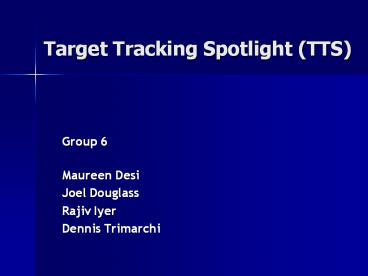Target Tracking Spotlight (TTS) - PowerPoint PPT Presentation
1 / 30
Title:
Target Tracking Spotlight (TTS)
Description:
Linearization of Dynamic Model. Experiment with Design Methods. Choose Simple PID Controller. Non-Linear Simulation of Dynamic Model. Motor 1 Motor 2. Linear vs. ... – PowerPoint PPT presentation
Number of Views:59
Avg rating:3.0/5.0
Title: Target Tracking Spotlight (TTS)
1
Target Tracking Spotlight (TTS)
Group 6
- Maureen Desi
- Joel Douglass
- Rajiv Iyer
- Dennis Trimarchi
2
Introduction
What Target illumination system that controls a
spotlight which is mounted on a stationary or
moving object.
Who Law Enforcement, Entertainment Industry
Why Accuracy, Economic Savings
3
Project Goal Objectives
Goal Successfully track and illuminate a moving
target
Objective Design a system to control a spotlight
mounted on the pan-tilt platform so that it
can follow and illuminate a moving target.
4
Original Design Specifications
5
Overall Design Approach
Sensors
Control
Identify Part Specifications
Simulation
Research
Order Parts
Order Parts
System Construction and Programming
System Construction
Data Acquisition Program
Testing (Parameter Identification)
Simulation Testing
Phase I Phase II
Phase III
6
Sensor System
- Research Order Parts
- System Construction
- Data Acquisition Program
- Simulation Testing
7
Research Order Parts
- Devantech SRF-04 Ultrasonic Ranger
- Voltage 5v only required
- Current 30mA Typ. 50mA Max.
- Frequency 40KHz
- Max Range 3 m
- Min Range 3 cm
- Sensitivity Detect a 3cm diameter stick at gt 2 m
- Echo Pulse Positive TTL level signal, width
proportional to range. - Small Size 43mm x 20mm x 17mm
8
Research Order Parts
- Devantech SRF-04 Ultrasonic Ranger
9
System Construction
Echo
8 bit Timer
Sensor Pair
PIC
ARCS
Trigger
Sensor Pair
Echo
Address Bits
10
Data Acquisition Program
11
Data Acquisition Program
12
Data Acquisition Program
R1
R2
13
Data Acquisition Program
14
Simulation Testing
15
Simulation Testing
R1
x
y
R2
Radius of Target is added to R1 and R2
16
Control System
- Order Parts
- Simulation
- System Construction Programming
- Testing
- Phase I II
17
Order Parts
- Verified selected motors met specifications
- Ran non-linear simulations to view torque and
speed requirements - Compared data of different sized motors
- Chose the best parts and placed the order
18
Option 1 Option 2
19
Simulation
- Linearization of Dynamic Model
- Experiment with Design Methods
- Choose Simple PID Controller
- Non-Linear Simulation of Dynamic Model
20
Motor 1 Motor 2
21
Linear vs. Non-linear
22
Outer Block Diagram
23
Demonstration Cases Block Diagram
24
Point to Point Case Block Diagram
25
Controller Block Diagram
26
Physical System PerformanceStep Response
27
Physical System PerformanceSine Tracking
28
Demonstration
29
Specification Comparison
30
Recommendations
- Implement a Low Pass Filter
- Use Trajectory Estimation Algorithm
- Incorporate SRF04 Pairs
- Use Higher Intensity Spotlight

